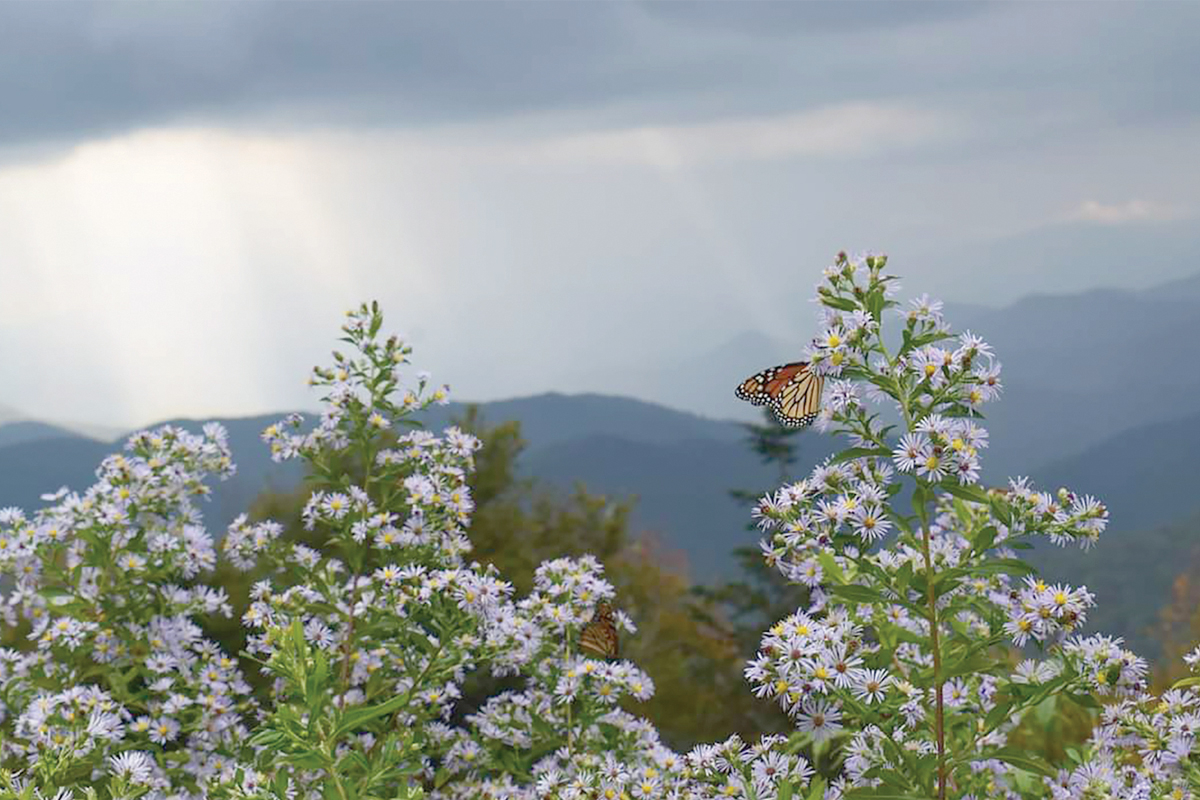Notes from a plant nerd: Go, go chasing butterflies
 A monarch butterfly drinks from an aster during its southward journey. Adam Bigelow photo
A monarch butterfly drinks from an aster during its southward journey. Adam Bigelow photo
Every year at the beginning of fall, an amazing thing happens in North America, and the Southern Appalachian Mountains.
One of the most amazing animal migrations just passes through Western North Carolina, and not only can you go witness it, but you can also help these amazing animals along the way.
Every year monarch butterflies (Danaus plexippus) set out from their summer homes in the northern U.S. and Canada to fly 3,000 miles to their wintering grounds in warmer climates. And each year they follow the same or similar routes as in previous years. They stop and drink nectar from the same fields of wildflowers, roost overnight in the same trees, and follow a similar route as their ancestors have the previous years, for millions of years. And sometimes, if you are lucky and time it well, you can find them on the Blue Ridge Parkway and stand among hundreds of monarchs swooping down for nectar or flying southward on their journey.
The majority of monarch butterflies spend the winter huddled in trees together by the millions in the mountains outside of Mexico City. They will leave the warm safety of numbers to flit down and drink nectar from flowers during the warmer days, and then gather in such amazing masses back in the trees that their weight, the weight of butterflies, causes the branches to droop and hang.
In the late winter, they leave Mexico and begin their long, multi-generational migration towards Canada and the northern U.S. It takes them three generations, all dependent on the many species of milkweed plants (Asclepias spp.) that serve as hosts for their caterpillars. These milkweeds, and a couple of other plant species that used to be in the milkweed genus of Asclepias, are the only plants in the world that monarchs will lay their eggs on, as it is the only food their caterpillars will eat. And you thought you had a picky child?
The monarchs then spend the summer in their northern reaches for two or three more generations, flying about and doing what monarchs do on their summer vacation. You know, drinking nectar, pollinating flowers, waterskiing, having barbecues, just normal summer vacation stuff. And then, in the fall they will fly all the way back to Mexico in one single, long-lived generation to reach the same overwintering grounds that their great, great, great, great, great, and sometimes great-grandparents did the year before. And they have been making this same journey, year after year, for millions of years. It is mind-boggling to me.
Related Items
And you can help them. In fact, this species, and so many others, could use our help. Our culture has decimated their traditional habitats and migration routes by replacing the native plants they evolved with, with millions of acres of corn, soy, wheat, lawns, golf courses and exotic plant landscapes. By planting and encouraging native plants back into these areas, we can help to make sure that the monarchs continue this journey long into the future.
They need milkweeds that are native to your bioregion for their spring journey. And in the fall, the adults rely on the abundance of nectar produced by asters (Symphyotricum and Eurybia spp.), goldenrods (Solidago spp.), ironweeds (Vernonia spp.), Joe Pye weeds (Eutrochium spp.) and other late-blooming flowers. As do so many other species of moth, butterfly, bees, wasps and other insects. If we continue to think of these plants as weeds and mow them down or spray them to death before they bloom, we will continue to see a decline in insect species all around.
This week, the monarch butterflies are migrating through the mountains, flying south and drinking nectar. I encourage you to go up onto the Blue Ridge Parkway and see if you can find them. Some common spots are the Cherry Cove Gap Overlook, Haywood Gap, Devil’s Courthouse parking area, Caney Fork Overlook and other spots along the way with an abundance of wildflowers in bloom. But do be careful as you drive along scanning the roadsides and skies for signs of monarchs, as the road is curvy and filled with tourists this time of year.
(Adam Bigelow lives in Cullowhee. He leads weekly wildflower walks most Fridays and offers consultations and private group tours through Bigelow’s Botanical Excursions. This email address is being protected from spambots. You need JavaScript enabled to view it..)









